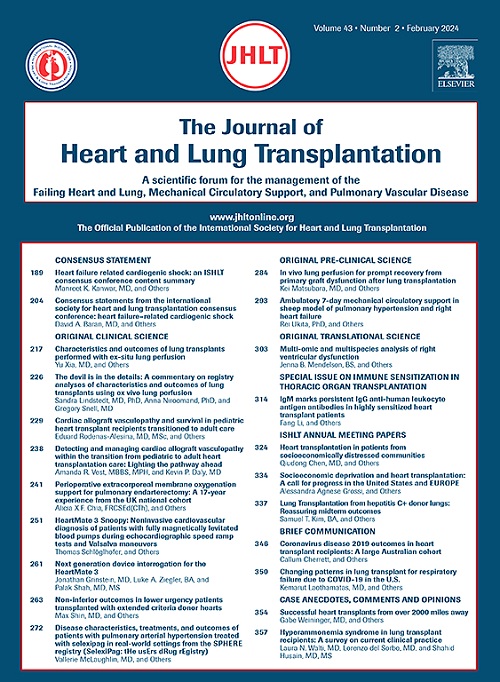通过体外清除中性粒细胞胞外捕获物恢复废弃猪肺。
IF 6
1区 医学
Q1 CARDIAC & CARDIOVASCULAR SYSTEMS
引用次数: 0
摘要
背景:中性粒细胞胞外捕获物(NET)可引起炎症和组织损伤,是吸入性肺损伤的潜在机制,也是肺移植(LTx)中供肺利用率低的主要因素:为了确定在体外肺灌注(EVLP)过程中清除NET是否能恢复吸入损伤肺的肺功能和形态,我们诱导了12头猪的胃吸入肺损伤。在确认急性呼吸窘迫综合征后,取出肺部并分配给与EVLP(治疗)相连的NET清除(6头)或仅EVLP(非治疗)(6头)。测量血流动力学,收集血液和组织样本以评估肺功能、形态学、作为NET标志物的无细胞DNA、细胞外组蛋白和核小体水平以及细胞因子水平:猪肺EVLP和NET清除后,PaO2/FiO2比值比单独进行EVLP的肺显著增加(p=0.0411)。与未处理的肺相比,处理过的肺在EVLP灌流液中的无细胞DNA(p=0.0260)和细胞外组蛋白水平较低(p=0.0260)。组织病理学显示,与未处理的肺相比,处理过的肺显示出较少的免疫细胞浸润和较少的水肿,这反映在EVLP灌流液和BALF中促炎细胞因子水平的降低上:总之,在EVLP过程中清除NET可改善吸入损伤供体肺的肺功能和形态。在EVLP过程中清除NET的能力可能代表了一种新的LTx治疗方法,并有可能扩大移植供体库。本文章由计算机程序翻译,如有差异,请以英文原文为准。
Restoring discarded porcine lungs by ex vivo removal of neutrophil extracellular traps
Background
By causing inflammation and tissue damage, neutrophil extracellular traps (NETs) constitute an underlying mechanism of aspiration-induced lung injury, a major factor of the low utilization of donor lungs in lung transplantation (LTx).
Methods
To determine whether NET removal during ex vivo lung perfusion (EVLP) can restore lung function and morphology in aspiration-damaged lungs, gastric aspiration lung injury was induced in 12 pigs. After confirmation of acute respiratory distress syndrome, the lungs were explanted and assigned to NET removal connected to EVLP (treated) (n = 6) or EVLP only (nontreated) (n = 6). Hemodynamic measurements were taken, and blood and tissue samples were collected to assess lung function, morphology, levels of cell-free DNA, extracellular histones, and nucleosomes as markers of NETs, as well as cytokine levels.
Results
After EVLP and NET removal in porcine lungs, PaO2/FiO2 ratios increased significantly compared to those undergoing EVLP alone (p = 0.0411). Treated lungs had lower cell-free DNA (p = 0.0260) and lower levels of extracellular histones in EVLP perfusate (p= 0.0260) than nontreated lungs. According to histopathology, treated lungs showed less immune cell infiltration and less edema compared with nontreated lungs, which was reflected in decreased levels of proinflammatory cytokines in EVLP perfusate and bronchoalveolar lavage fluid.
Conclusions
To conclude, removing NETs during EVLP improved lung function and morphology in aspiration-damaged donor lungs. The ability to remove NETs during EVLP could represent a new therapeutic approach for LTx and potentially expand the donor pool for transplantation.
求助全文
通过发布文献求助,成功后即可免费获取论文全文。
去求助
来源期刊
CiteScore
10.10
自引率
6.70%
发文量
1667
审稿时长
69 days
期刊介绍:
The Journal of Heart and Lung Transplantation, the official publication of the International Society for Heart and Lung Transplantation, brings readers essential scholarly and timely information in the field of cardio-pulmonary transplantation, mechanical and biological support of the failing heart, advanced lung disease (including pulmonary vascular disease) and cell replacement therapy. Importantly, the journal also serves as a medium of communication of pre-clinical sciences in all these rapidly expanding areas.

 求助内容:
求助内容: 应助结果提醒方式:
应助结果提醒方式:


